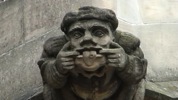A sad tale’s best for winter. Mamilius, Act 2, Sc. 1, L.26.
Recognised as one of Sh’s later plays, approx. 1611, it is based on Robert Greene’s novel Pandosto: the Triumph of Time, which dates back to the beginnings of Sh’s London career around 1590-ish. For orthodox biographers Greene is the one who makes the first official allusion to Sh. in his Green’s Groatsworth of Wit, approx. 1592. Greene was quite a lad about town and one of the famed University Wits. He died in poverty, depending on the charity of a poor couple.
This blog assumes you know the play. If not, read it! Leontes becomes insanely jealous of his best friend Polixenes, and his wife, Hermione within 10 lines. Antigonus gets told to lose their baby daughter Perdita on the coast of Bohemia (see if you can google.earth that one). Then he gets chased and eaten by a bear in the most descriptive stage direction we have from Sh. (exit pursued by a bear). Hermione re-enacts an Ovidian myth as the statue that re-animates. Time as the chorus gives a 16 couplet intro to Act 4, mirroring the number of years his daughter Perdita is banished. So how old is she now?
The Winter’s Tale contains the 4 themes dealt with in most of Sh’s plays.
1. Conflict- rivalry in love and war; within or between families; etc.
2. Appearance and Reality- Women as men, evil bastards are seemingly kind, characters pretend to be mad, actors and acting within the play being acted.
3. Order and Disorder- disturbances in persons, nature and society.
4. Metamorphosis- Characters change in some way along with the backgrounds wherein they are presented.
Other themes:
Romance, the balance between Divine and Human moral tone, Time, Sins of the powerful and elderly, the natural goodness of youth, Supernatural phenomena or Providence vs human virtue, Religious experience vs human impotence, Mercy and the power of Love (spiritual not sexual),Art orders human affairs to show how they resist destruction and decay of time.
Imagery:
Life, Law and rhythm, Working in men and nature, Changes of colour in face, Flowers, Garden, Sickness and medicine.
I must confess to having found my notes from the Shakespeare Institute: an A4 with the themes, a children’s breakdown of the story plus synopsis from the A-Z by Terry Hands, and a photo-copy of the play from my First Folio facsimile. Peter Holland, then director of Institute and now at Notre Dame, provided the insight into the length of Time’s prologue to act 4 being the necessary 32 lines long.

Leave a Reply
You must be logged in to post a comment.